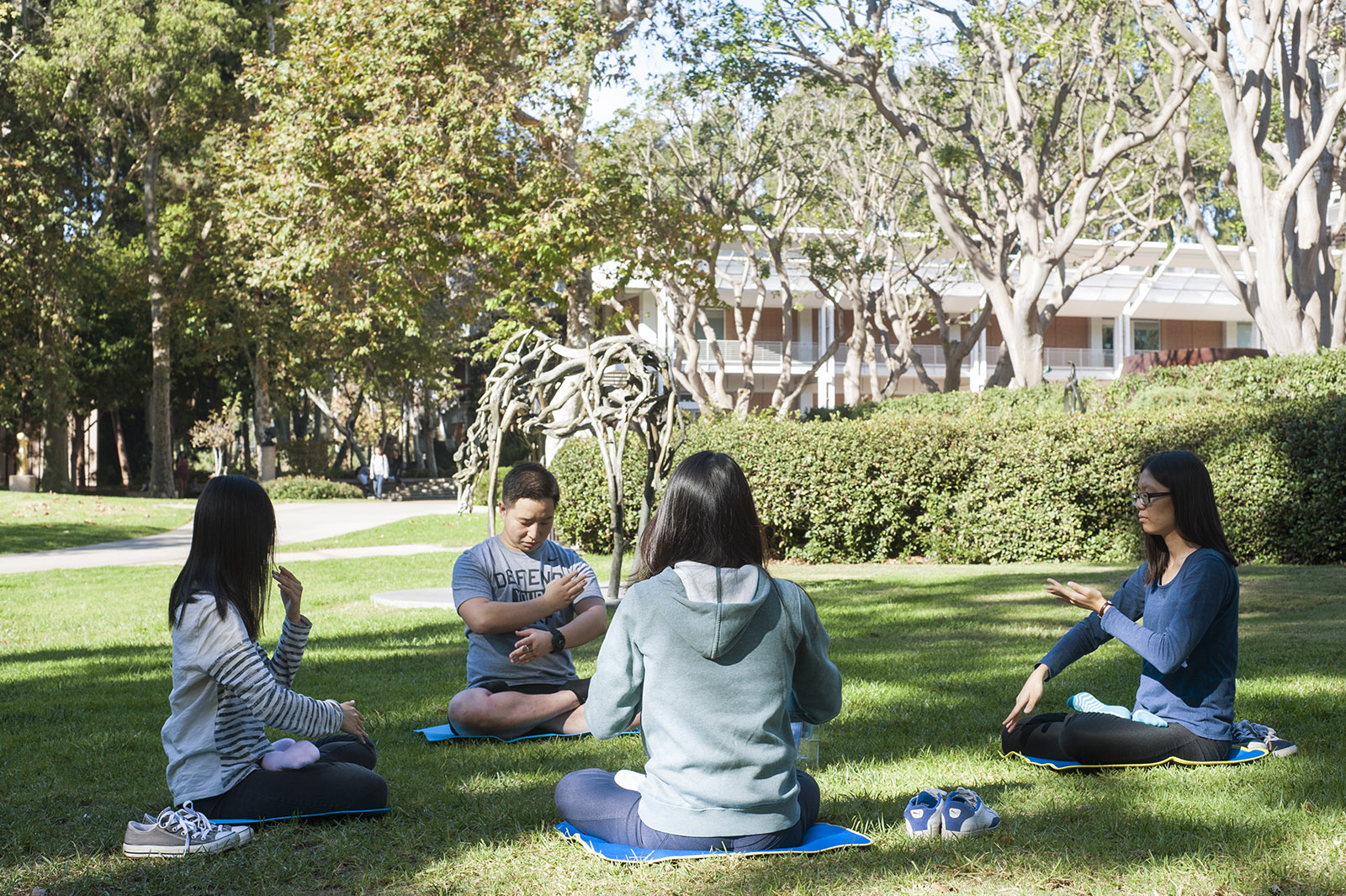Art exhibit aims to showcase Falun Dafa in positive light

Students in UCLA’s Falun Dafa club practice qigong meditation, which is banned in China. The club’s new exhibit, “The Art of Truthfulness,” plans to challenge negative stigmas surrounding the practice. (Burcu Turkay/Daily Bruin)
The Art of Truthfulness, Compassion and Forbearance
Hosted by the Falun Dafa Club
Kerckhoff Art Gallery
Nov. 7 through Nov. 13
FREE
By Alexandra Del Rosario
Nov. 7, 2016 9:37 p.m.
Taiwanese television stations in the 1990s broadcasted Falun Dafa persecutions in Tiananmen Square in China, where the meditation practice is shunned.
First-grader Joyce Kuo, a practitioner of the meditation, was worried while watching the images on television in her home in Taiwan because she knew her family could receive negative attention.
Now a fourth-year history student, Kuo freely practices Falun Dafa at UCLA’s Falun Dafa club. Comprised of five members, the group meets four days a week to practice qigong meditation in the Franklin D. Murphy Sculpture Garden. The club is presenting copies of 16 paintings by professional artists and Falun Dafa practitioners in its first art exhibit, open through Sunday at Kerckhoff Art Gallery. The exhibit, titled “The Art of Truthfulness, Compassion and Forbearance,” aims to challenge Falun Dafa’s historically cultish reputation, Kuo said.
“People don’t necessarily have to know Falun Dafa in order to appreciate and gain interest in what is portrayed,” Kuo said. “The displayed art is beautiful and meaningful enough to make the viewer think and reflect.”
Kuo and third-year civil engineering student Lucas Huang started the club in January and hope the upcoming exhibit’s paintings, some of which depict meditators with their legs crossed and eyes closed, will dispel negative connotations associated with Falun Dafa, Huang said.
[Throwback: Meditate to find relief from college stress]
Huang, who is from mainland China, learned about the history and practice of Falun Dafa from his father. In 1999, the Chinese Communist Party hired actors to falsely portray Falun Dafa practitioners as insane radicals in an effort to mitigate their potential threat to the Communist regime, Huang said. Huang feels the stigma that Falun Dafa is radical and evil has extended to the United States, he said. Falun Dafa, currently banned in China, is a spiritual art created by Li Hongzhi in 199 and practiced in tandem with qigong, a set of physical and breathing exercises. Falun Dafa incorporates the three principles of truthfulness, compassion and forbearance with five sets of qigong meditation intended to help the user reach inner peace and enlightenment.
Since the Chinese government has perpetuated negative and cultish images of Falun Dafa followers eating their children and burning themselves, Kuo said she feels responsible for bringing a more positive perspective to the practice.
Kuo’s grandfather, who was born and raised in Taiwan, practiced qigong to combat his chronic illness, she said. Kuo’s mother learned from him and passed it down to her daughter, Kuo said.
“Falun Dafa and the qigong practices are a good way to relieve the heavy stresses of being a student,” Kuo said. “It refreshes my mind and gives me enough energy to keep working.”
The art exhibit will focus on Falun Dafa’s meditative component by displaying paintings of meditators, animals, instruments, serene environments and celestial bodies, Kuo said. They will evoke a sense of serenity, purity and meditation, Huang said.
[Related: Art Gallery showcases work of LGBTQ and disabled community]
The painting “In Harmony” portrays a woman performing a qigong exercise. Four cherubs frolic overhead, demonstrating the connection made with higher beings through the application of the principle tenets, Huang said.
While many of the paintings show people practicing Falun Dafa peacefully, some other pieces depict the artists’ darker experiences of the persecution taking place in China, Huang said.
“Lotus Candle” shows rows of brightly glowing candles, which are meant to represent the growing number of practitioners persecuted by the Chinese government, Huang said. Other pieces such as “Homeless,” which depicts imagery of a destroyed future, and “Stirred by her Song,” based off of an American woman’s experience in China during the start of persecutions, document firsthand experiences to show the violence of the state of Falun Dafa in China, he said.
“In showing paintings by people who have experienced Falun Dafa and the persecutions, we hope the outlook towards Falun Dafa would not be as hostile,” Huang said.
Club member Claire Liu said since she has been practicing Falun Dafa her whole life, she insists on continuing to practice at UCLA despite any possible negative reception. The first-year environmental science student finds comfort in practicing Falun Dafa in open spaces like the sculpture garden with other students, Liu said.
“The environment here at UCLA is much more accepting than it is in China, where I practiced with my family,” Liu said. “As I have found the club, I hope many other students will find the club, too.”
Liu believes the art of the upcoming exhibit reflects the positive energy she feels practicing Falun Dafa, she said.
“If the art in the gallery spreads the same good energy I experience when practicing Falun Dafa, then people will understand what Falun Dafa really is and will hopefully gain interest in learning more,” Liu said.

